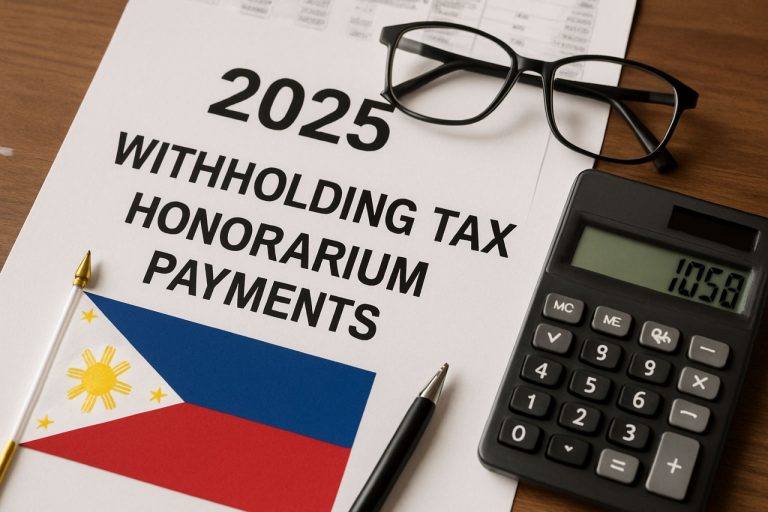
Table of Contents
- Overview: Tax System in the Philippines for 2025
- Key Tax Law Changes Effective 2025
- Income Tax Updates for Individuals and Businesses
- Value-Added Tax (VAT) and Indirect Tax Changes
- Compliance and Reporting: New Requirements & Digitalization
- Penalties, Audits, and Enforcement Trends
- Latest Statistics: Tax Revenue, Collection, and Gaps
- Sector-Specific Tax Impacts: SMEs, Freelancers, and Corporates
- 2025–2030 Outlook: Planned Reforms and Global Alignment
- Where to Find Official Guidance and Resources (bir.gov.ph, dof.gov.ph)
- Sources & References
Overview: Tax System in the Philippines for 2025
The tax system in the Philippines is governed primarily by the National Internal Revenue Code (NIRC), as amended, and is administered by the Bureau of Internal Revenue (BIR). As of 2025, the Philippine tax regime combines national and local taxes, with the national government collecting income, value-added, excise, and documentary stamp taxes, while local governments impose property, business, and community taxes.
Significant reforms over the past decade, most notably the Tax Reform for Acceleration and Inclusion (TRAIN) Law and the Corporate Recovery and Tax Incentives for Enterprises (CREATE) Act, have reshaped the landscape. The TRAIN Law, implemented in 2018, adjusted personal income tax brackets, providing relief to low- and middle-income earners and broadening the VAT base. The CREATE Act, effective from 2021, reduced the corporate income tax rate from 30% to 25% (or 20% for certain small businesses) and rationalized fiscal incentives for enterprises in the Philippines Department of Finance. These reforms continue to impact the tax environment in 2025, with the government maintaining the adjusted rates and incentives structure.
For individuals, the graduated income tax rate for compensation earners in 2025 ranges from 0% for annual incomes up to PHP 250,000, to 35% for incomes exceeding PHP 8 million. Corporate taxpayers generally face a 25% regular income tax, while qualified micro, small, and medium enterprises (MSMEs) benefit from a reduced 20% rate. The Value-Added Tax (VAT) rate remains at 12%, applied to the sale of goods and services, as well as imports Bureau of Internal Revenue.
Tax compliance is enforced through regular filing requirements, including monthly and quarterly returns for VAT, income, and withholding taxes. Electronic filing and payment systems continue to be promoted, with the BIR’s Electronic Filing and Payment System (eFPS) and Electronic BIR Forms (eBIRForms) seeing expanded use among both individuals and corporations in 2025 Bureau of Internal Revenue.
The Philippine government remains focused on improving tax collection efficiency and broadening the tax base. In 2025, the administration is pursuing digitalization of tax processes and enhanced audit efforts to address tax evasion and boost revenues, which are essential for funding infrastructure and social programs. The Department of Finance projects continued revenue growth, with tax revenues expected to reach over 15% of GDP in 2025 Department of Finance. Looking ahead, further reforms may target indirect taxes and digital economy taxation as the government seeks to adapt to evolving business models and sustain fiscal stability.
Key Tax Law Changes Effective 2025
The Philippine tax landscape is undergoing significant transformation in 2025, marked by the implementation of several key legislative reforms. Foremost among these is the continued rollout of the Comprehensive Tax Reform Program (CTRP), a multi-phase initiative intended to create a simpler, fairer, and more efficient tax system.
A pivotal component effective in 2025 is the full implementation of the Corporate Recovery and Tax Incentives for Enterprises (CREATE) Act, which further reduces the regular corporate income tax rate from 30% to 25% for large corporations and as low as 20% for micro, small, and medium enterprises (MSMEs) registered with the Securities and Exchange Commission. The CREATE Act also rationalizes fiscal incentives, introducing a performance-based, time-bound, and transparent incentives system for qualified investors and exporters, which is managed and monitored by the Fiscal Incentives Review Board (Bureau of Internal Revenue).
Another significant change is the implementation of the Ease of Paying Taxes (EOPT) Act (Republic Act No. 11976), which takes effect in 2025. The EOPT Act amends the National Internal Revenue Code by simplifying compliance requirements, such as allowing electronic filing of returns, reducing documentary requirements, and harmonizing tax deadlines across different taxpayer classes. The law also introduces “small taxpayer” categories, offering further streamlined processes for MSMEs. This is projected to improve the Philippines’ ranking in the World Bank’s “Ease of Doing Business” index and enhance voluntary compliance (Bureau of Internal Revenue).
From a compliance perspective, 2025 sees stricter enforcement of electronic invoicing and receipt systems. Under the Electronic Invoicing/Receipting System (EIS), certain taxpayers, particularly those engaged in export or e-commerce, must issue digital receipts and transmit transaction data in real time to the Bureau of Internal Revenue. The EIS is expected to cover a broader range of taxpayers in the coming years, as part of the government’s digital transformation agenda (Bureau of Internal Revenue (EIS Portal)).
Key statistics from the Department of Finance show tax collections in 2023 reached a record ₱3.14 trillion, a trend projected to continue with improved compliance measures. Looking ahead, the Philippine government aims to further broaden the tax base, enhance digital tax administration, and introduce new measures to address profit shifting, aligning with global best practices.
Income Tax Updates for Individuals and Businesses
The Philippine tax landscape continues to evolve in 2025, reflecting ongoing reforms aimed at broadening the tax base, improving compliance, and fostering economic growth. The most significant recent changes stem from the Tax Reform for Acceleration and Inclusion (TRAIN) Law and the Corporate Recovery and Tax Incentives for Enterprises (CREATE) Act, both of which have shaped the income tax regime for individuals and businesses.
For individuals, the TRAIN Law fully implemented the adjusted personal income tax brackets in 2023, reducing the tax burden for most taxpayers and exempting those earning an annual taxable income of ₱250,000 or less. These rates remain in effect for 2025, with the next scheduled adjustment set for 2028. The highest marginal tax rate for individuals is now 35% for annual taxable income above ₱8 million. The Bureau of Internal Revenue (BIR) continues to emphasize digitalization, with electronic filing and payment systems now mandatory for most taxpayers, a move designed to enhance efficiency and compliance (Bureau of Internal Revenue).
For corporations, the CREATE Act, effective since 2021, implemented a gradual decrease in the regular corporate income tax rate from 30% to 25% for large corporations and 20% for domestic micro, small, and medium enterprises (MSMEs) with net taxable income not exceeding ₱5 million and total assets not exceeding ₱100 million, excluding land. These rates are projected to stay stable through 2025. The Act also rationalized fiscal incentives, introducing a performance-based and time-bound system overseen by the Fiscal Incentives Review Board (Department of Finance).
Compliance remains a key focus for authorities. The BIR has intensified audit programs and continues to adopt digital tools for tax administration. In 2024, the BIR launched the Digital Transformation (DX) Roadmap, which expands the use of online registration, filing, and payment portals, and increases the use of data analytics to flag non-compliance (Bureau of Internal Revenue Digital Transformation). Taxpayers are urged to keep up-to-date with these changes to avoid penalties and interest for late or incorrect filings.
According to the latest data, tax collections in 2023 reached ₱2.34 trillion, a 7.7% increase year-on-year, reflecting post-pandemic recovery and improved enforcement (Department of Finance). For 2025 and beyond, tax authorities aim to further boost collections through digitalization and expanded taxpayer education. While no major new income tax legislation is expected in 2025, ongoing reviews may lead to additional simplification and compliance measures in the coming years.
Value-Added Tax (VAT) and Indirect Tax Changes
The Philippines’ Value-Added Tax (VAT) system remains a central pillar of its indirect taxation framework, generating significant revenue for public spending. As of 2025, the standard VAT rate continues at 12%, imposed on the sale of goods and services, and on imports, under the National Internal Revenue Code, as amended by Republic Act No. 10963 (TRAIN Law). Notably, the VAT threshold for small businesses remains at PHP 3 million in annual gross sales or receipts, below which VAT registration is not mandatory, offering relief to micro, small, and medium enterprises (MSMEs) Bureau of Internal Revenue.
Recent years have seen a strong compliance push from authorities. The Bureau of Internal Revenue (BIR) is accelerating the adoption of digital invoicing and receipt systems, following Revenue Regulations No. 8-2022, which mandates large taxpayers and exporters to transition to electronic invoicing by July 2024. This digital transformation, expected to expand further in 2025, aims to curb VAT leakages and improve real-time monitoring of transactions, enhancing overall tax compliance Bureau of Internal Revenue.
The government has also clarified VAT exemptions and zero-rated transactions, particularly for exporters and renewable energy projects, through Revenue Regulations No. 3-2023 and subsequent issuances. These provide guidance on qualifying for VAT zero-rating, notably for local purchases by export enterprises registered with investment promotion agencies, as part of the government’s investment incentives under the Corporate Recovery and Tax Incentives for Enterprises (CREATE) Act Philippine Economic Zone Authority.
Statistically, VAT and other indirect taxes accounted for over one-third of total tax collections in 2023. The BIR reported VAT collections of PHP 460 billion for that year, with a targeted increase in 2025 as compliance measures intensify Bureau of Internal Revenue. The outlook for the next few years includes ongoing scrutiny of VAT-exempt sectors, continued digitalization, and possible policy adjustments to broaden the tax base. The Department of Finance is also reviewing VAT on digital services and cross-border e-commerce, signaling potential changes in indirect tax policy to keep pace with the evolving digital economy Department of Finance.
Compliance and Reporting: New Requirements & Digitalization
The Philippines is undergoing significant transformation in tax compliance and reporting, driven by regulatory reforms and digitalization initiatives. These changes aim to modernize the tax system, improve transparency, and enhance taxpayer experience while strengthening enforcement capacity.
A major milestone is the implementation of the Bureau of Internal Revenue’s (BIR) Digital Transformation (DX) Roadmap 2020–2030. This program includes the phased rollout of online tax filing, payment systems, and document management, designed to streamline compliance and minimize manual intervention. By 2025, the BIR is expanding e-services, such as the Electronic Filing and Payment System (eFPS), Electronic Audited Financial Statement (eAFS), and enhanced Electronic Tax Clearance System (eTCS), making electronic submission mandatory for many taxpayer categories, including large taxpayers and certain VAT-registered entities. This shift is in line with the BIR’s goal to achieve a fully digital tax administration by 2030 (Bureau of Internal Revenue).
Compliance requirements have also tightened under recent legislation. The Tax Reform for Acceleration and Inclusion (TRAIN) Law and the Corporate Recovery and Tax Incentives for Enterprises (CREATE) Act introduced stricter reporting rules, including mandatory e-invoicing for large taxpayers and exporters. The BIR’s Revenue Regulations No. 8-2022 and 9-2022 further require taxpayers to keep electronic books of accounts and submit digital supporting documents. Starting July 2024, the Electronic Invoicing/Receipting System (EIS) has become mandatory for certain sectors, signaling broader adoption in 2025 and beyond (Bureau of Internal Revenue).
Penalties for non-compliance are also being more rigorously enforced. The BIR has clarified that failures in electronic filing or delayed digital submissions may lead to administrative fines and even criminal liability in severe cases. Taxpayers are therefore urged to update their internal systems and train staff to meet the evolving standards (Bureau of Internal Revenue).
Key statistics highlight the impact of digitalization: As of late 2023, the BIR reported a 90% e-filing rate among large taxpayers, with collection efficiency rising by 12% year-on-year. The government anticipates that, by 2025, over 95% of all tax filings will be electronic, further reducing opportunities for error and fraud (Department of Finance).
Looking ahead, the outlook is for continued tightening of compliance standards and expanded digitalization. The BIR is piloting AI-driven audit tools and exploring blockchain for secure recordkeeping. Businesses should expect more rigorous enforcement and monitoring, and should invest in digital infrastructure to mitigate compliance risks in the coming years.
Penalties, Audits, and Enforcement Trends
The Philippines continues to strengthen its tax enforcement regime, with penalties, audit mechanisms, and compliance priorities evolving in 2025 and the coming years. The Bureau of Internal Revenue (BIR) and the Bureau of Customs (BOC) remain the primary agencies overseeing tax compliance and enforcement.
Penalties: Under the Philippine National Internal Revenue Code (NIRC), tax deficiencies typically incur a 25% surcharge for failure to file or pay on time, and a 50% surcharge for fraudulent returns or willful neglect. Additionally, deficiency interest of 12% per annum is imposed on unpaid taxes. Recent BIR issuances reaffirm strict enforcement of these penalties, with continued application of criminal penalties for tax evasion and related offenses, including imprisonment and fines for serious violations (Bureau of Internal Revenue).
Audits: The BIR has intensified its audit activities, especially targeting high-risk sectors and large taxpayers. The agency utilizes a risk-based audit selection system, with priority given to industries identified as having high incidence of tax leakage or non-compliance. In 2024, BIR issued Revenue Memorandum Circulars reiterating audit timelines and requirements, and in 2025, digital submission of supporting documents is increasingly required during audits. The BIR Large Taxpayers Service continues to spearhead specialized audits of corporations and multinational firms, contributing to rising collections (Bureau of Internal Revenue).
Enforcement Trends:
- Expanded “Run After Tax Evaders” (RATE) program, with BIR filing more criminal complaints against individuals and corporations suspected of tax fraud. In 2023, the BIR filed over 200 cases, and this trend is expected to continue or increase in 2025 (Bureau of Internal Revenue).
- Enhanced inter-agency cooperation, particularly with the Securities and Exchange Commission (SEC) and Anti-Money Laundering Council (AMLC), to identify hidden income and suspicious transactions.
- Greater use of digital tools for tracking e-commerce and online transactions, as part of the BIR’s Digital Transformation Roadmap 2020-2030, with new systems supporting audit and enforcement (Bureau of Internal Revenue).
Outlook: Enforcement measures are expected to remain robust through 2025 and beyond, with continued emphasis on digitalization, risk-based audits, and inter-agency intelligence sharing. Taxpayers can expect more automated notices, expanded document digitization requirements, and stricter penalties for non-compliance. The government aims to increase the tax-to-GDP ratio by minimizing evasion and broadening the tax base (Department of Finance).
Latest Statistics: Tax Revenue, Collection, and Gaps
In 2025, the landscape of tax revenue and collection in the Philippines reflects both steady progress and persistent challenges. The government’s principal collecting agencies—primarily the Bureau of Internal Revenue (BIR) and the Bureau of Customs (BOC)—remain central to national fiscal capacity, as mandated by the National Internal Revenue Code and relevant amendments.
For fiscal year 2024, the BIR reported a collection of PHP 2.34 trillion as of November, representing a 9.2% increase year-on-year and closely tracking its annual target of PHP 2.64 trillion. The BOC, meanwhile, contributed PHP 813.6 billion in revenue, surpassing its target for the same period. Collectively, tax collections are projected to account for approximately 15.6% of the country’s gross domestic product (GDP) in 2025, according to government planning documents from the Department of Budget and Management.
Despite these gains, the Philippines continues to grapple with a “tax gap”—the difference between potential and actual collections. Data from the Department of Finance (DOF) estimates the overall tax gap at around 3.2% of GDP for 2024, with VAT compliance and personal income tax underreporting as major contributors. Key compliance challenges include a still-substantial informal sector, tax evasion, and administrative inefficiencies. The government’s digitalization drive—such as the BIR’s online filing systems and e-receipting initiatives—has improved voluntary compliance and reduced leakages, but full digital integration remains a multi-year endeavor.
- 2024 tax effort (tax revenue as % of GDP): 15.6%
- BIR collection target for 2025: PHP 2.68 trillion
- BOC collection target for 2025: PHP 874 billion
- Tax gap (estimated): 3.2% of GDP
Moving forward, the outlook for tax revenue hinges on continued economic recovery, legislative reforms (including adjustments to VAT exemptions and possible digital services taxation), and further improvements in tax administration. The government aims to raise the tax effort to 17.1% of GDP by 2028, in line with the Medium-Term Fiscal Framework (National Economic and Development Authority). Achieving this will require not only stronger enforcement but also inclusive policies to bring informal businesses into the tax net and enhance transparency.
Sector-Specific Tax Impacts: SMEs, Freelancers, and Corporates
The Philippine tax landscape for 2025 presents significant developments for Small and Medium Enterprises (SMEs), freelancers, and corporate entities, shaped by recent legislative reforms and evolving regulatory priorities. The government continues to pursue tax modernization and digitalization, aiming to broaden the tax base, enhance compliance, and foster a more equitable business environment.
- SMEs: The Corporate Recovery and Tax Incentives for Enterprises (CREATE) Act, implemented in recent years, continues to impact SMEs in 2025. The law permanently reduced the corporate income tax rate for domestic corporations with net taxable income not exceeding PHP 5 million and total assets not exceeding PHP 100 million (excluding land) from 30% to 20%. This measure aims to boost liquidity and competitiveness among smaller businesses. The Bureau of Internal Revenue (BIR) sustains simplified compliance requirements and digital reporting platforms to facilitate tax filings for SMEs Bureau of Internal Revenue.
- Freelancers and Self-Employed: Freelancers and self-employed professionals remain subject to graduated income tax rates under the TRAIN Law, with annual income below PHP 250,000 exempt from income tax. Those earning below PHP 3 million annually may opt for an 8% flat tax on gross receipts in lieu of graduated rates and percentage tax, streamlining the process for micro-entrepreneurs and gig economy workers. The BIR has increased scrutiny of online transactions and digital freelancers, requiring proper registration and the issuance of official receipts for services rendered Bureau of Internal Revenue.
- Corporates: For larger corporations, the CREATE Act reduced the regular corporate income tax rate from 30% to 25%. Additional incentives are provided for businesses engaged in priority sectors or operating within special economic zones, subject to performance-based, targeted, and time-bound criteria. The Fiscal Incentives Review Board (FIRB) continues to assess and rationalize tax incentives to ensure alignment with national development objectives Fiscal Incentives Review Board.
Key statistics from 2023 indicate a sustained increase in tax collections, driven by improved digital compliance and economic recovery. For FY 2024 and 2025, the government is targeting higher revenue through expanded audits and the rollout of electronic invoicing systems. The outlook suggests ongoing reforms, with proposed legislation to further digitalize tax administration and enhance SME support mechanisms. Compliance will increasingly hinge on adopting digital tools and timely regulatory updates, affecting all taxpayer segments in the coming years Department of Finance.
2025–2030 Outlook: Planned Reforms and Global Alignment
The period from 2025 through 2030 is poised to be transformative for the Philippine tax landscape, as the government intensifies efforts toward modernization, efficiency, and global alignment. Following recent legislative successes such as the Corporate Recovery and Tax Incentives for Enterprises (CREATE) Act and the Tax Reform for Acceleration and Inclusion (TRAIN) Law, authorities are advancing new reforms to further streamline tax administration and respond to international pressures for transparency and digitalization.
- Digitalization and Compliance Initiatives: The Bureau of Internal Revenue (BIR) is set to expand its digitalization program through 2025, with the goal of automating more taxpayer services, enhancing electronic filing, and reducing manual intervention in audit and collections. The BIR’s Digital Transformation Roadmap targets full digitalization by 2030, reflecting a broader government strategy for e-governance to improve compliance and reduce corruption.
- Global Tax Alignment: The Philippines is actively preparing for the implementation of the OECD’s global minimum tax (Pillar Two) rules, which mandate a 15% minimum effective corporate tax rate for large multinational enterprises. The Department of Finance (DOF) has indicated legislative proposals will be introduced in 2025 to ensure compliance with international standards, safeguarding the country’s investment climate while preventing profit shifting and base erosion.
- VAT and Indirect Tax Reforms: Proposals under consideration include further rationalization of value-added tax (VAT) exemptions and enhanced collection mechanisms. The DOF’s 2025 budget briefings highlight plans to streamline VAT refund systems and broaden the tax base—critical to increasing the VAT effort, which currently lags behind regional peers (Department of Budget and Management).
- Key Statistics and Revenue Outlook: Tax revenue is expected to reach 16.2% of GDP by 2025, up from 15.3% in 2023, driven by ongoing reforms and improved tax administration (National Economic and Development Authority). The government aims for continued incremental gains, targeting a 17% tax-to-GDP ratio by 2030.
- Enforcement and Anti-Evasion: Enhanced audit procedures, stricter penalties, and expanded use of third-party data analytics are part of the BIR’s strategy to close the tax gap and address persistent evasion, with pilot programs already yielding higher compliance rates.
Overall, the outlook for Philippine taxes from 2025 to 2030 is one of modernization and harmonization with global standards. While challenges remain around legislative passage and implementation, the direction is clear: the Philippines is committed to an efficient, transparent, and competitive tax regime that supports sustainable development and international cooperation.
Where to Find Official Guidance and Resources (bir.gov.ph, dof.gov.ph)
Navigating the tax landscape in the Philippines requires staying up-to-date with the latest laws, regulations, and compliance requirements. For individuals and businesses seeking authoritative information and official guidance, two primary government resources stand out: the Bureau of Internal Revenue (BIR) and the Department of Finance (DOF).
- Bureau of Internal Revenue (BIR): The BIR is the principal tax collection agency in the Philippines. Its official website (Bureau of Internal Revenue) offers comprehensive resources for taxpayers, including updated forms, step-by-step filing instructions, tax advisories, revenue regulations, and online services such as the eFPS and eBIRForms platforms. The BIR regularly updates its portal with circulars and memoranda addressing evolving compliance requirements, deadlines for annual and quarterly tax filings, and recent changes implemented through legislative measures.
- Department of Finance (DOF): The DOF oversees fiscal policy, tax reform, and public revenue measures. Its official website (Department of Finance) provides executive issuances, press releases on new tax policies, and updates on legislative developments such as the Comprehensive Tax Reform Program (CTRP). The DOF also publishes analyses and statistics relevant to the Philippines’ fiscal performance, revenue targets, and macroeconomic outlook, which are essential for understanding the broader context of tax policy.
For 2025 and the coming years, both agencies are critical sources for updates about ongoing tax reform, digitalization of tax administration, and compliance guidelines in light of evolving economic conditions. For example, the BIR continues to release guidance on the use of electronic invoicing and receipt solutions, aligning with the government’s digital transformation objectives under the Tax Reform for Acceleration and Inclusion (TRAIN) and other CTRP packages. These digital initiatives are expected to expand, impacting compliance processes and taxpayer obligations (Bureau of Internal Revenue).
Taxpayers are encouraged to regularly consult these official websites for the latest issuances, especially as new rules, forms, and procedures are introduced to reflect policy changes anticipated in 2025 and beyond. Both the BIR and DOF also offer hotlines, public advisories, and FAQs to assist with compliance and to clarify uncertainties regarding tax obligations and reforms.



